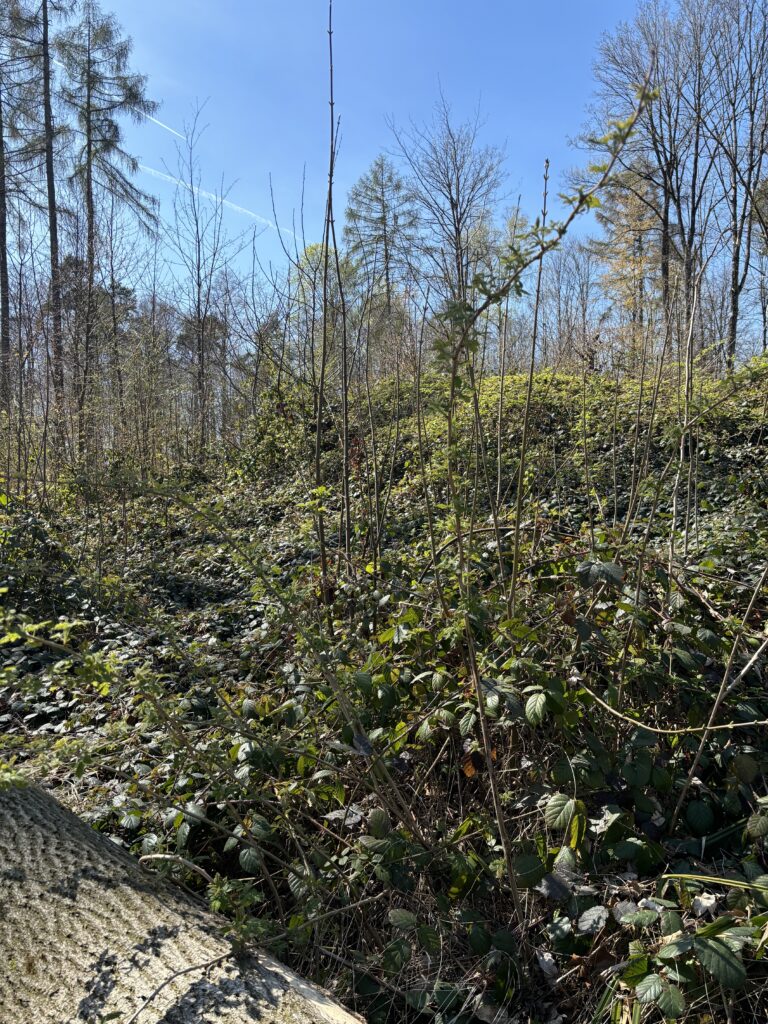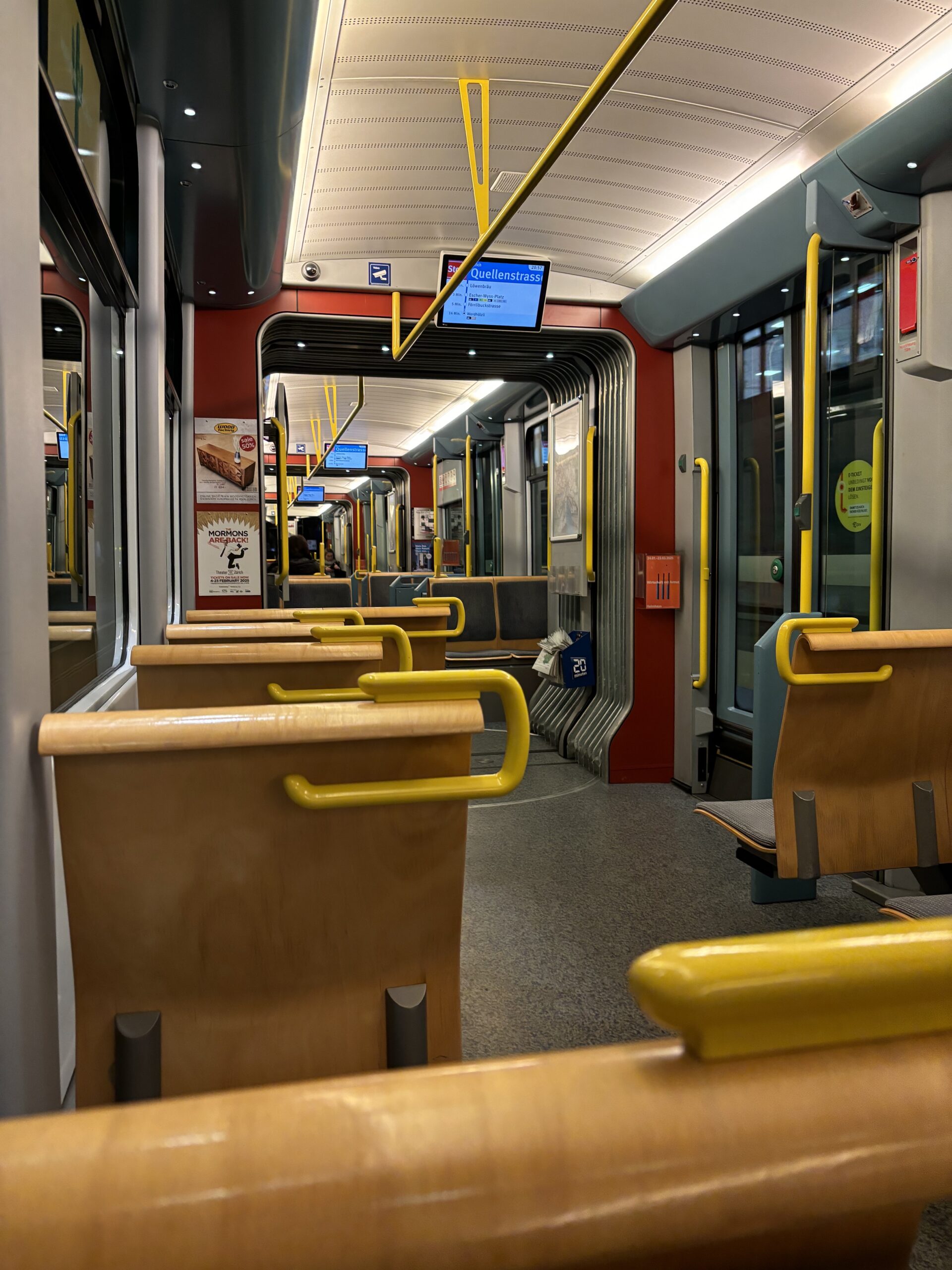- Exploring Sound Qualities in Architectural Design
For the first assignment, I made recordings in two very different kinds of spaces within my dorm building. Each with its own acoustic qualities.
The dining hall
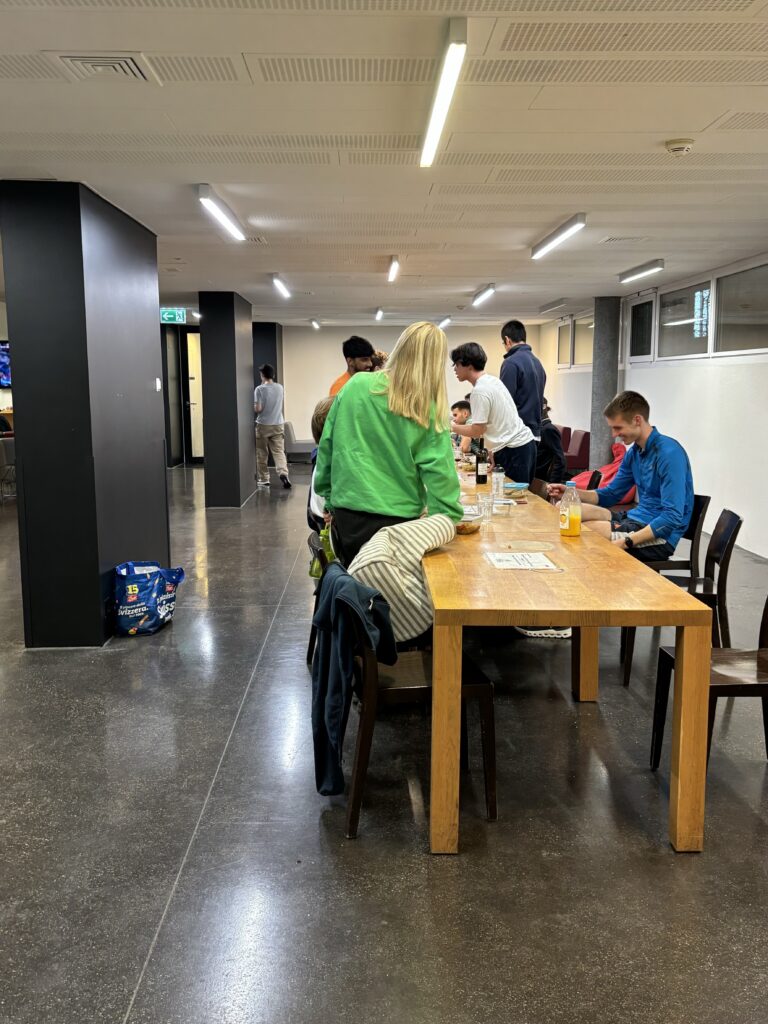
The first recording is from the dormitory’s dining area. As over a hundred students live here, the dining area is usually filled with people, and it can often get quite loud and noisy.
The room is quite large, but with a relatively low ceiling. It features concrete walls and pillars, as well as large glass window (on the side not visible in the image), but it’s quite lacking sound absorbing materials.
In the recording, you can hear the sound of people chatting, cutlery clinking, and water running in the kitchen, which is adjacent to the dining hall.
The sound can be described as boisterous, reverb-y and boomy.
The corridor
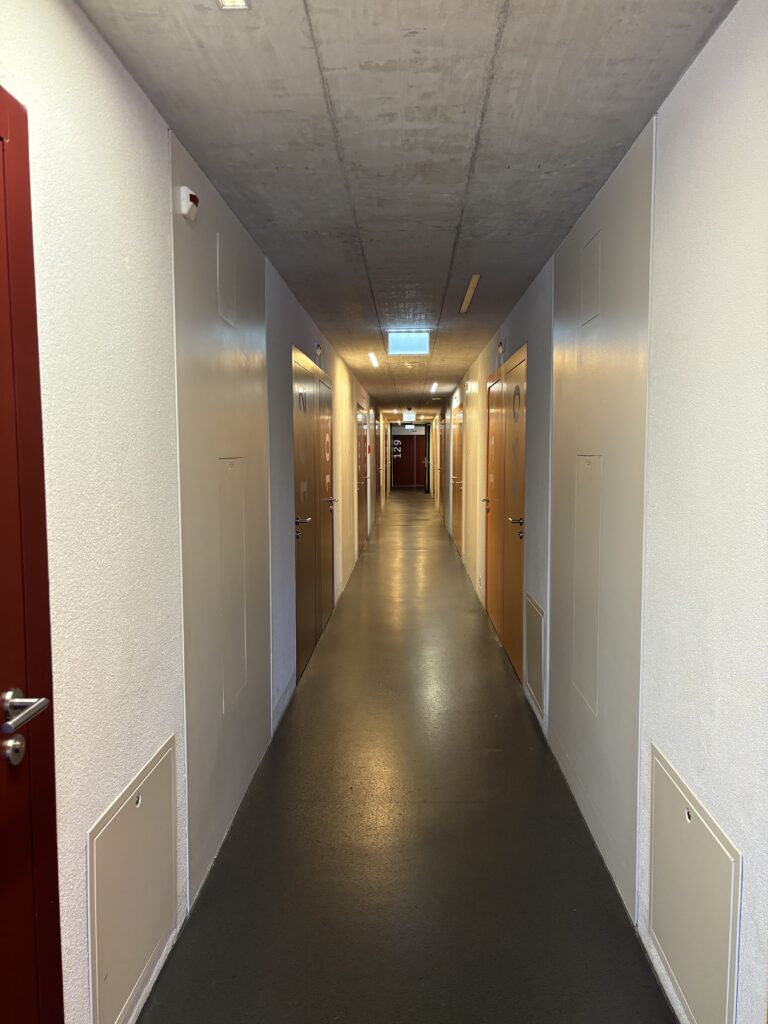
The corridor is a very long and narrow space, with concrete walls and ceiling, lined with doors on both side leading into the dorm rooms.
The room is very quiet. Appart from some distant sounds from elsewhere in building, the only sounds you can hear clearly is of me running and clapping.
Similarly to the dining hall, the sounds here can also be described as boomy and reverb-y. The sounds have a long reverberation time. I would also describe the sounds as rather muddy.
2. Exploring the Emotional Impact of Everyday sounds
On the tram
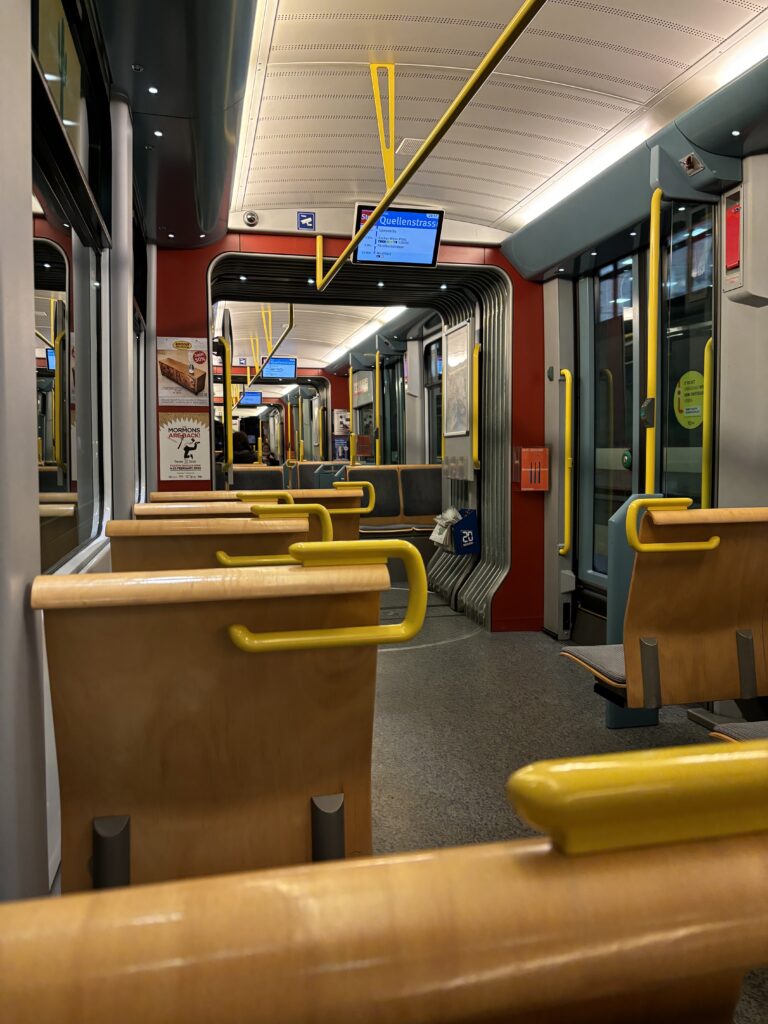
I made my first recording while I was on my way home on the tram.
I would say that the most emerging sounds are those produced by the tram itself. The sound that appear the loudest on the recording is the very low-frequency rumble of the tram moving forward on the tracks – a sound I actually didn’t pay much attention to while I was on the tram. There, I was more aware of the humming and buzzing sounds of the engine. I think the reason for this sound being more catchy is that it’s more in the mid- to high-frequency range, and also because it changes in loudness and frequency as the tram accelerates and slows down, while the low frequency sounds of the tram are more constant.
Another very prominent sound is the sound of people talking. A sound that is very catchy, as your brain quite automatically tries to catch what’s being said.
Another sound that can be heard is the sound of the windows rattling. A sound I find very annoying, as it’s quite loud and very irregular. You can also hear the doors opening and closing as the tram stops, as well as the speakers announcing the next destination.
Over all, the sounds inside the tram can be described as loud and very varied, with different noises varying in frequency and volume. Some predictable, and others irregular and random. The sound would probably bother me very much elsewhere, but on the tram, it’s so expected that it doesn’t really bother me at all – though it might be a bit tiring after a while.
At a café
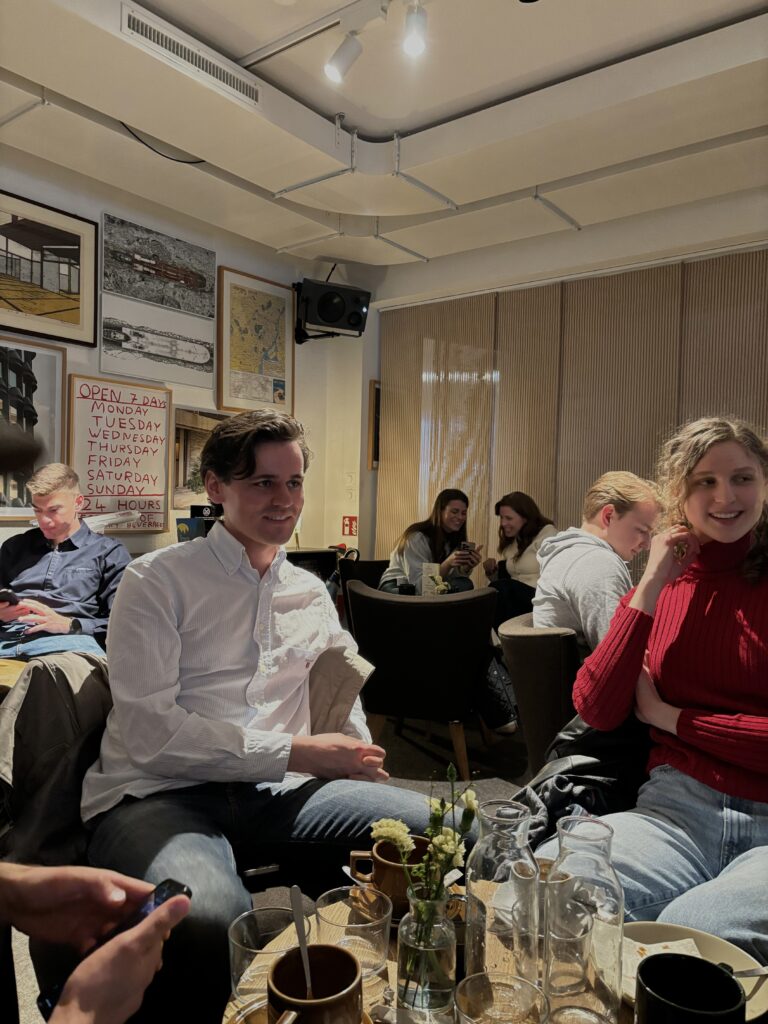
I made my second recording while I was having a coffee with my friends at the Monocle shop & café. We went to the café at a rather busy time, and it was full of people.
The loudest and most emergent sound is the chatter of people talking. You can also hear the clinking of glass and cutlery, as well as the sound of work behind the counter.
Something I notice much more now that I listen back to the recording than when I was at the café is the background music. On the recording, it seems more prominent, while at the café, it blended very well into the background noises.
The constant sounds, chatter and music seem to merge into a whole, with no noise really breaking through from the background. The soundscape was quite pleasant over all, but a bit too loud, with sounds from all direction, making it a bit tiring and hard to focus on my friends conversation.
3. Empirical and Numerical Estimation of Room Acoustic Properties
For this exercise I made an estimation of the acoustic properties in the corridor in my dorm.

From the graph, I estimated the the RT30 to 0,72 s. This making the RT60 2×0,72=1,44 s.
4. The Full Picture
For this exercise, I decided to revisit and make a more in depth analysis of the dining hall at my dorm.
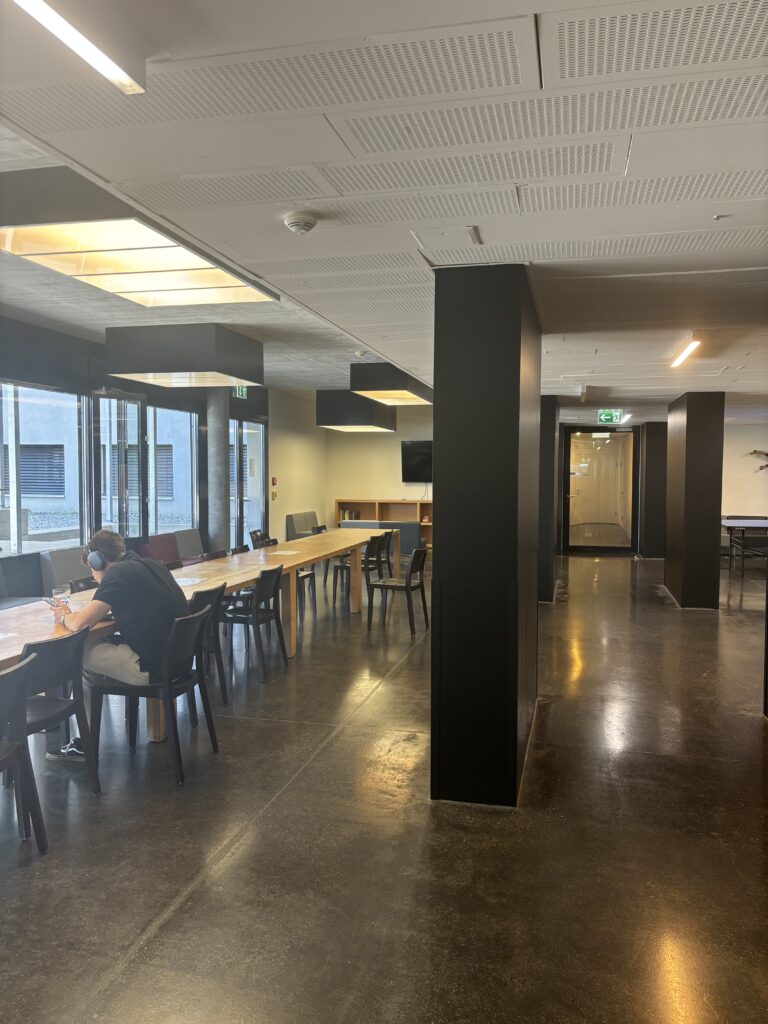
The dining hall is located at the ground floor of the dorm, connected to the kitchen and the main entrance. Its primary function is to provide a space for the dorm residents to eat and to socialize, but during the day, it also serves as a workspace for students to study.
Standards and guidelines:
DIN 18041:
Recommended reverberation time:
Dining area: RT60 of 1.0 – 1.2 seconds
Workspace: RT60 of 0.6 – 0.8 seconds
Recommended sound pressure level:
Dining area: 35 – 45 dB(A)
Workspace: 30 – 35 dB(A)
Recommended A/V ratio:
Dining area: B2 → A/V ≥ 0.15 (m²/m³)
Workspace: B3 → A/V ≥ 0.20 (m²/m³) or B4 → A/V ≥ 0.20 (m²/m³)
SUVA:
Maximum recommended noise exposure level:
Canteen: 55 dB(A)
Classroom: 40 dB(A)
Minimum sound level requirement:
Canteen: 38 dB(A)
Classroom: 28 dB(A)
SIA 181 Standards:
Recommended background noise level:
Classroom: ≥ 28-30 dB(A)
Recommended reverberation time:
Classroom: ≤ 0.8 seconds
Target values based on standards and guidelines:
To make the space well functioning both as a dining hall and a study area, I should aim for the acoustic criteria somewhere between the guidelines for the canteen/dining area and the workspace/classroom.
Reverberation time: RT60 0.8 – 1.0 seconds
A/V ratio: ≥ 0.20 (m²/m³)
Maximum noise exposure level: 50 dB(A)
Background noise level: around 30 dB(A)
Current acoustic situation:
The room is rather large and rectangular in shape, measures approximately 18 meters in length, 12 meters in width and 3 meters in height.
The room consists mostly of hard and highly sound reflective surfaces, with painted concrete walls, large glass windows and a floor of sealed polished concrete. A large part of the ceiling is also made out of concrete, but an even larger part is covered with painted perforated ceiling tiles, placed above the liveliest area of the room. These tiles are designed to reduce reverberation, especially in the mid- to high-frequency range. I believe these tiles have a significant impact on improving the speech intelligibility and overall acoustics of the room.
Apart from the ceiling, the room is lacking absorbing materials, with no curtains, carpets or similar use of soft materials. The furnishing is mostly made of wood. There are also some chairs upholstered in leather, but leather is not a very sound absorbing material either.
Calculations:
Room volume:
18×12×3=648 m³.
Floor, sealed polished concrete:
18×12=216 m²
Sealed polished concrete → α = 0.015
Ceiling, concrete:
3,5×18=63 m²
Concrete rough finish → α = 0.04
Ceiling, acoustic tiles:
8,5×18=153 m²
Acoustic tiles → α ≈ 0.75
Walls, painted concrete:
18×3+12×3+12×3=126 m²
Painted concrete (textured masonry paint) → α = 0.025
Windows, glass:
18×3=54 m²
Glass → α = 0.04
Total surface area:
216+63+153+126+54 = 612 m²
Sabines formula:
RT60 = 0.161⋅V/Aα
V = 648 m³
Aα = (216×0.015)+(63×0.04)+(153×0.75)+(126×0.025)+(54×0.04) = 3.24+2.52+114.75+3.15+2.16 = 125.82 sabins
RT60 = 0.161⋅V/A = 0.161⋅648/125.82 ≈ 0.83 s
Eyrings formula:
RT60 = 0.161⋅V/A⋅(1-ln(1-Aα/V))
V = 648 m³
A = 612 m²
Aα = 125.82 sabins
RT60 = 0.161⋅648/612⋅(1-ln(1-125.82/648)) ≈ 0.14 s
A/V ratio:
V = 648 m³
A(α)= 125.82 sabins
A/V = 125.82/648 ≈ 0.19 (m²/m³)
Conclusions:
The calculations are approximate, and I didn’t account factors such as the furnishing and the irregularities of the space, such as the pillars. Including these elements, as well as more precise measurements, would probably lead to a more accurate result. However, I do think that the result of my rough calculations seem to be reasonable and make sense overall.
I think using the Sabines calculation is more accurate for this room as it is fairly large with moderate and quite homogenous absorption. According to this equation, the RT60 is 0.83 seconds, which falls right within the target range of RT60 0.8 – 1.0 seconds. This making the room adequately acoustically treated for its purpose.
However, according to the Eyerings formula, the reverberation time is slightly too long, with the RT60 being 0.14 seconds. The A/V ratio is also slightly to low, as I calculated it to 0.19 (m²/m³), while the target value is ≥ 0.20 (m²/m³). Looking at these result, the room could benefit from having a bit more sound absorbing material. I think very small interventions, such as adding curtains by the windows and maybe some cushions for the chairs, could be quite sufficient.
5. Final Assignment
The Model and Design workshop space is a multipurpose room functioning both as a workshop and a lecture room. It’s a medium sized rectangular room dominated by hard surfaces, with concrete displayed in both walls, floor and ceiling, and only a negligeabel amount of softer materials. One of the walls is partly covered by some sort of fiber panels, or similar. The panels are have a painted surface, and are quite thin and hard, so I therefore don’t believe they provide any significant acoustic benefits.
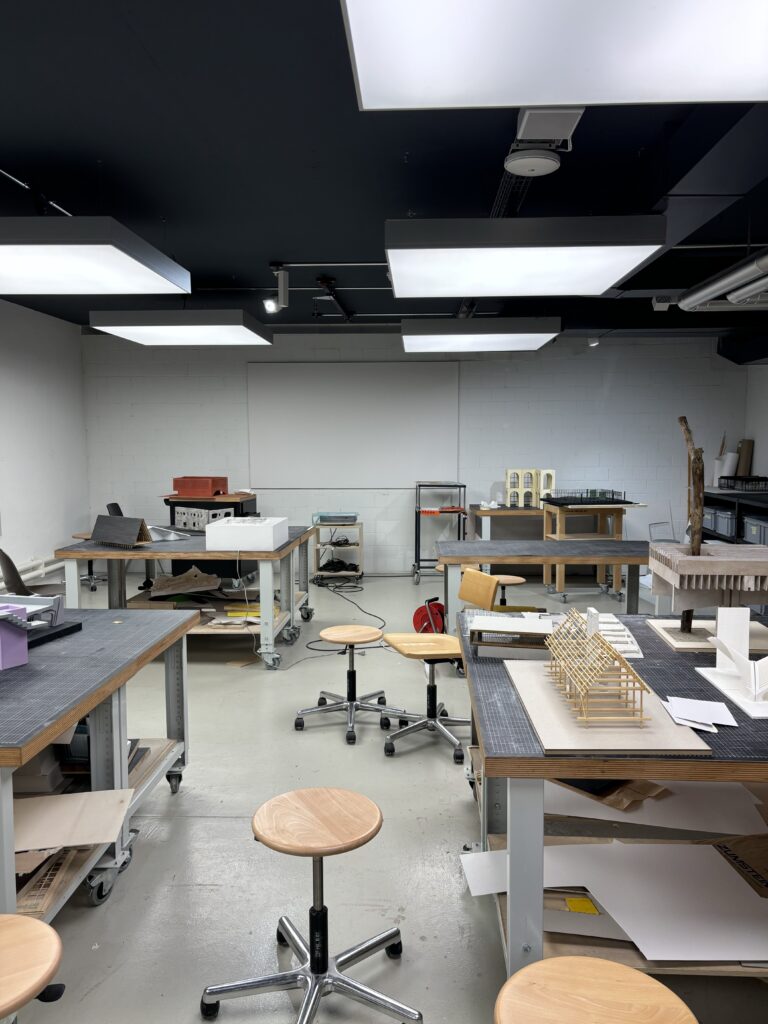
At present, the acoustics of the room can be described as boomy and reverbery, witch echoes making it feel bigger and emptier than it actually is.
Just from a quick first impression, it is quite clear that the room is not acoustically well adapted for its purpose, but to get a slightly more accurate understanding of the acoustic properties, the reverberation time was calculated. This was done by popping a balloon and calculating the RT60 using Audacity.

From the recording, I measured a RT30 of 0.56 seconds, making the RT60 2 × 0.56 = 1.12 seconds.
As the primary use of the room is educational, and should work for both frontal speech and communication amongst multiple speakers, I would categorize it as a A3 in the DIN 18041 guidelines.
The room has a volume of 237 m². For a room of this size in category A3, the guidelines suggests a RT60 of approximately 0.6 seconds.
According to the guidelines, the RT60 of the room is about 0,52 seconds too long, making it evident that the room is not acoustically properly treated for its purpose.
So, order to make the room align with the guidelines, I would have to lower the RT60 from 1.12 seconds to 0.6 seconds.
I propose doing this by adding sound absorbing materials to the room. For the function of the room, it’s not suitable to add carpets, curtains or soft furnishing. I would therefor propose focusing on the walls and the ceiling.
In the ceiling, I would put perforated panels. This to reduce reflection and absorb much of the mid frequencies, which is important in educational environment. Another reason for choosing these panels is also that they are quite aesthetically pleasing compared to many other absorbers. A would add these perforated panels evenly on the entire ceiling, as I think it would be needed, and in order to create a balanced acoustic environment.
I don’t think only the perforated ceiling would be sufficient though. I would therefor propose also adding porous absorbing panels on the walls. This to also take care of the high frequencies. I would distribute them evenly on all walls (to create an even absorption in the room) except the one behind the lecturer, as this wall, without absorption, can be helpful in directing the sound towards the audience. Putting absorption here would worsen the speech intelligibility.
Sabines formula can be used to calculate the current and the target absorption area of the room, as well as the average absorption coefficient.
Current Aα:
Aα = 0.161⋅V/RT = 0.161⋅237/1.12 ≈ 34 sabins
Target Aα:
Aα = 0.161⋅V/RT = 0.161⋅237/o.6 ≈ 63 sabins
I therefore want to add 63-34 = 29 sabins to the room
The total surface area of the room (S) = 275 m²
αavg. current = Acurrent/Stotal = 34/275 = 0.12
αavg. target = Atarget/Stotal = 63/275 = 0.23
Listening Exercise: Seeking Silence
